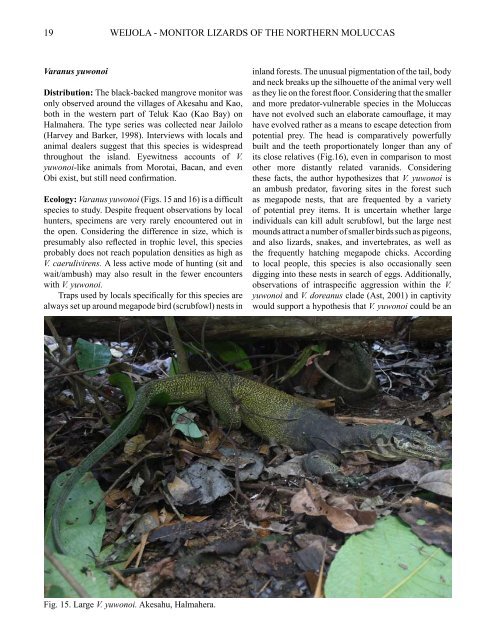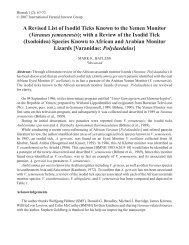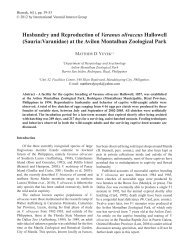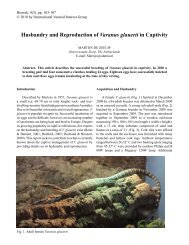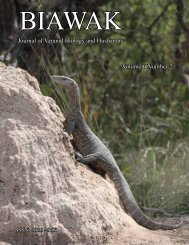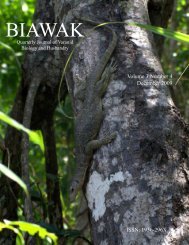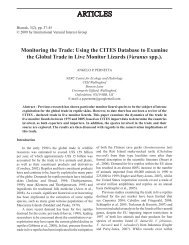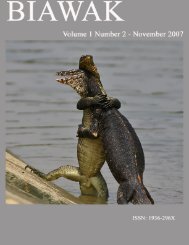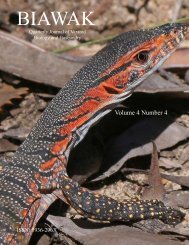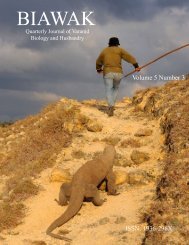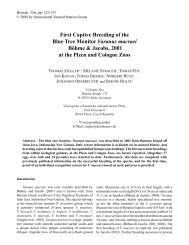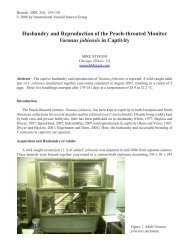Vol. 4 No. 1 - International Varanid Interest Group
Vol. 4 No. 1 - International Varanid Interest Group
Vol. 4 No. 1 - International Varanid Interest Group
You also want an ePaper? Increase the reach of your titles
YUMPU automatically turns print PDFs into web optimized ePapers that Google loves.
19<br />
Varanus yuwonoi<br />
WEIJOLA - MONITOR LIZARDS OF THE NORTHERN MOLuccAS<br />
distribution: The black-backed mangrove monitor was<br />
only observed around the villages of Akesahu and Kao,<br />
both in the western part of Teluk Kao (Kao Bay) on<br />
Halmahera. The type series was collected near Jailolo<br />
(Harvey and Barker, 1998). Interviews with locals and<br />
animal dealers suggest that this species is widespread<br />
throughout the island. Eyewitness accounts of V.<br />
yuwonoi-like animals from Morotai, Bacan, and even<br />
Obi exist, but still need confirmation.<br />
ecology: Varanus yuwonoi (Figs. 15 and 16) is a difficult<br />
species to study. Despite frequent observations by local<br />
hunters, specimens are very rarely encountered out in<br />
the open. considering the difference in size, which is<br />
presumably also reflected in trophic level, this species<br />
probably does not reach population densities as high as<br />
V. caerulivirens. A less active mode of hunting (sit and<br />
wait/ambush) may also result in the fewer encounters<br />
with V. yuwonoi.<br />
Traps used by locals specifically for this species are<br />
always set up around megapode bird (scrubfowl) nests in<br />
Fig. 15. Large V. yuwonoi. Akesahu, Halmahera.<br />
inland forests. The unusual pigmentation of the tail, body<br />
and neck breaks up the silhouette of the animal very well<br />
as they lie on the forest floor. Considering that the smaller<br />
and more predator-vulnerable species in the Moluccas<br />
have not evolved such an elaborate camouflage, it may<br />
have evolved rather as a means to escape detection from<br />
potential prey. The head is comparatively powerfully<br />
built and the teeth proportionately longer than any of<br />
its close relatives (Fig.16), even in comparison to most<br />
other more distantly related varanids. considering<br />
these facts, the author hypothesizes that V. yuwonoi is<br />
an ambush predator, favoring sites in the forest such<br />
as megapode nests, that are frequented by a variety<br />
of potential prey items. It is uncertain whether large<br />
individuals can kill adult scrubfowl, but the large nest<br />
mounds attract a number of smaller birds such as pigeons,<br />
and also lizards, snakes, and invertebrates, as well as<br />
the frequently hatching megapode chicks. According<br />
to local people, this species is also occasionally seen<br />
digging into these nests in search of eggs. Additionally,<br />
observations of intraspecific aggression within the V.<br />
yuwonoi and V. doreanus clade (Ast, 2001) in captivity<br />
would support a hypothesis that V. yuwonoi could be an


